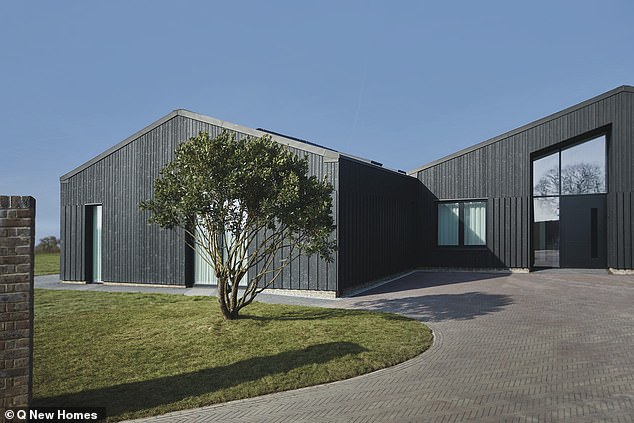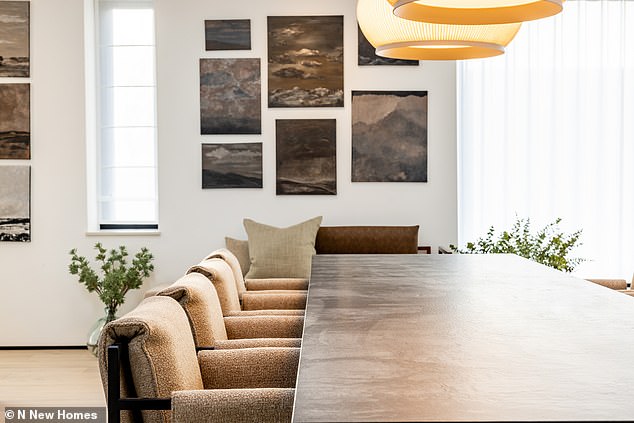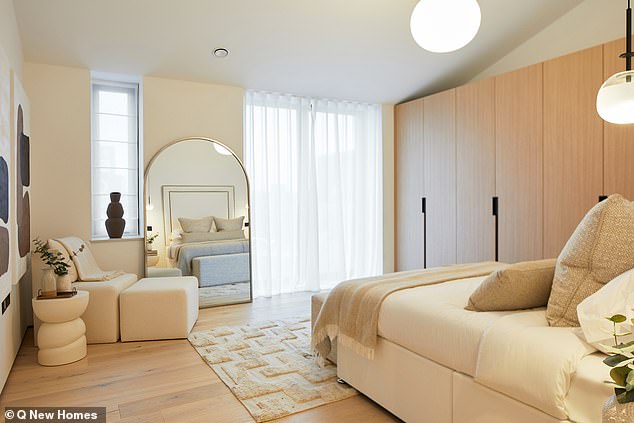Too many new homes being built are ‘unsustainable’ before they’ve ever been lived in, two brothers and co-founders developing homes across Britain claim.
Damien and Michael Wynne, of Q New Homes, say that while some developers claim to be eco-conscious, many still use materials like concrete and steel.
The duo claim steel and concrete ‘are some of the world’s biggest carbon culprits.’
The pair added: ‘Greener homes are simply better homes’.
Labour plans to build 1.5million homes by the end of parliament and Energy Secretary Ed Miliband recently said the Government would ‘double down’ on its environmental agenda and accused those against the move to net zero of ‘making up nonsense and lies’.
This week , Miliband confirmed the Government was looking at plans to charge homes in the South more for electricity, after critics warned of a potential ‘postcode lottery.’

Net zero push: Damien and Michael Wynne co-founded Q New Homes in 2012
Speaking to This is Money, the Wynne Brothers, said: ‘Too many new homes are being fitted with renewable tech—like air-source heat pumps and solar panels—without getting the basics right first.
‘This means future residents are left feeling like they’ve made eco-conscious choices, yet don’t see the benefits reflected in their energy bills.
‘Most new homes are still built with a “volume over values” mindset—cheap materials, minimal insulation, and no long-term thinking.
‘The materials used by many developers—especially concrete and steel—are some of the world’s biggest carbon culprits.
‘Add in plastics, foams, and other synthetics that are cheap to use but almost impossible to recycle, and you’ve got homes that are unsustainable before they’re even lived in.’
The brothers claim their new housing development, Hartdene Barns in Kent, is ’15 years ahead of what current building regulations require in terms of energy efficiency, insulation and sustainability.’
The duo are both developers and main contractors at the site, using their own team for much of the work.
Most of the nine ‘net-zero’ properties are complete, but works are ongoing on some.
The homes are built to meet the targets of the Royal Institute of British Architects Climate Challenge.

Eco living: Hartdene Barns in Kent comprises nine luxury homes

Wow: Q Net Homes said Hartdene Barns could be viewed as the greenest homes in the UK

Get saving: Prices for a home at Hartdene Barns start from £1.25m and move up to £2.5m

Get green-fingered: Some of the allotments at Hartdene Barns

Neutral: The neutral interior of one of the Hartdene Barn properties

Luxury living: As well as being eco-friendly, Hartdene Barns offers high-end living

Design: The homes at Hartdene Barn have been constructed from structural insulated panels

Doubling down: Ed Miliband said the government would ‘double down’ on its environmental agenda
Q New Homes claims Hardene Barns ‘could be considered the greenest set of homes in the country.’
Prices for the homes start from £1.25million for a three-bedroom terraced house, moving up to £2.5million for a four-bedroom link detached barn.
The homes at Hartdene Barn have been constructed from structural insulated panels with gulam beams rather than steel, and low-carbon concrete.
The structurally insulated panels used to form the walls of the houses are hermetically sealed ‘for optimism heat retention’. The panels, according to Q New Homes, release 40 per cent less carbon than conventional building materials.’
The homes at Hartdene Barns all have underfloor heating by an air source heat pump rather than a gas boiler, and each is fitted with up to 32 solar panels which should generate enough power to heat and light the properties ‘for free virtually all year round.’
According to Q New Homes, this means residents of Hartdene Barns will have no electricity bills.
It said: ‘The only utilities the owners need to pay for are water and broadband.’
Each property at Hartdene Barns also comes with a ‘no-dig’ allotment in a communal garden, meaning residents can grow their own fruit and vegetables for free and with zero food miles.
Nestled on a former dairy farm, the Hartdene Barns development is situated near Cowden, an historic village close to the point where the counties of Kent, East Sussex and Surrey meet.
The Wynne brothers said that their homes were ‘built for long-term comfort, low running costs, and lasting environmental benefit.’
The pair added: ‘What most developers don’t realise is that just about every material in a typical home has a carbon-neutral alternative—even concrete.
‘Hartdene Barns is net-zero by design—not just in energy use, but in how we source materials, reduce waste, and plan for the future. It’s proof that when sustainability is the starting point, not an afterthought, we can build homes that work for families and the planet.
‘It’s time to stop building homes that become problems the minute people move in—too cold, too costly, too wasteful. Greener homes are simply better homes.’
Britain is legally committed to moving to net zero carbon emissions by 2050, which is a a goal set under a previous Conservative government.
As part of Angela Raynor and Ed Miliband’s green plans, landlords will be forced to secure an energy performance certificate rating of C in all privately rented homes by 2030. They are currently required to have an EPC rating of E.
Labour has said that doing so could reduce the average tenant’s energy bill by £240 per year, as well as improve the general quality of rented homes.







